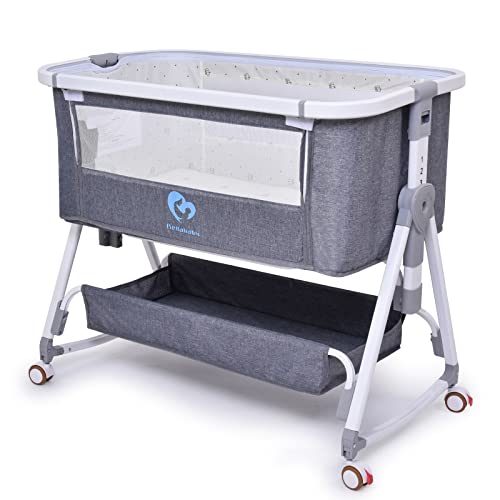9 Things Your Parents Taught You About Bedside Cot For Safe Infant Sleep
Bedside Cot for Safe Infant Sleep: A Comprehensive Guide
Making sure safe sleep for an infant is a top concern for parents and caregivers. When it pertains to promoting safe sleep practices, selecting the ideal sleep environment is vital. A bedside cot, also understood as a co-sleeper or sidecar crib, can be an excellent option for assisting in safe and convenient nighttime look after babies. This article explores the advantages, factors to consider, and important functions of bedside cots, helping parents make notified options for their infants' sleeping arrangements.
What is a Bedside Cot?
A bedside cot is a type of crib that attaches to the side of an adult bed. It allows parents to keep their baby close while supplying a different sleeping space, promoting safe sleep practices. Bedside cots are available in different designs, sizes, and products, dealing with the varied requirements of households.
Advantages of Using a Bedside Cot
Bedside cots use numerous advantages for parents and infants, including:
Convenience: Parents can quickly take care of their baby during the night without rising. This makes feeding, comforting, and keeping an eye on the kid more manageable.
Promotes Breastfeeding: For breastfeeding moms, a bedside cot enables much easier access to the baby for nighttime feedings, which can improve the breastfeeding experience.
Lowers the Risk of Sudden Infant Death Syndrome (SIDS): Sleep specialists suggest that having the infant near a moms and dad while still in their own space can reduce the threat of SIDS. This arrangement encourages safe sleep conditions, such as placing the baby on their back in a separate sleeping surface free from soft bedding.
Creates a Comfortable Sleep Environment: Bedside cots usually feature breathable sides and appropriate ventilation, providing a comfortable sleeping environment for infants.
Reduce of Transition: As infants grow and shift to independent sleeping, bedside cots facilitate this change without substantial interruption to the child's sleep regimen.
Key Features to Look for in a Bedside Cot
When choosing a bedside cot, certain features can enhance the safety and use of the sleeping arrangement. Here are some necessary elements to consider:
Adjustable Height: The cot needs to have several height settings to line up with the adult bed, guaranteeing a safe fit and easy access to the baby.
Tough Construction: The products utilized need to be durable and capable of supporting the baby's weight without wobbling or collapsing.
Breathable Mesh Panels: These enhance visibility and air flow while assisting to decrease suffocation hazards.
Security Straps: Many styles featured straps or anchors to securely attach the cot to the adult bed, preventing any gaps where the infant might unintentionally roll.
Portable and Lightweight Design: If parents plan to travel or move the cot to different rooms, a lightweight and foldable design makes it practical for different settings.
Easy to Clean: Removable, washable fabrics are important for preserving hygiene, specifically with the frequent messes connected with infants.
How to Setup a Bedside Cot Safely
Establishing a bedside cot involves a few simple steps to guarantee safety and convenience for the baby. Here is a checklist parents can follow:
Choose a Flat Surface: Ensure the cot is placed on a flat and stable surface area to avoid tipping.
Protect Attachment: Follow the manufacturer's instructions to securely connect the cot to the adult bed using safety straps or anchors, making sure there are no gaps between the 2 sleeping surfaces.
Change the Height: Set the cot to the appropriate height, aligning it with the adult bed for easy access.
Look for Stability: Before positioning the baby in the cot, inspect its stability by gently shaking it. If there is any motion, reassess the installation.
Prevent Soft Bedding: Use a company, flat mattress in the cot and prevent soft toys or loose bedding, as these can develop suffocation threats.
Common Concerns About Bedside Cots
While bedside cots offer numerous benefits, possible issues can emerge amongst parents. Here are some typical questions:
FAQs about Bedside Cots
Are bedside cots safe?
- Yes, when used correctly, bedside cots are thought about safe. Parents must guarantee proper setup and follow safety guidelines to mitigate any risks.
At what age can I use a bedside cot?
- Bedside cots appropriate for infants from birth till they can roll over or sit up individually, generally around 5-6 months. After Bedside Cot For Cribs , transitioning to a crib might be suitable.
Can I use a bedside cot if I have a thicker mattress?
- A lot of bedside cots are adjustable in height, so they can accommodate various mattress densities. Ensure to follow the manufacturer's guidelines for safe attachment.
Are bedside cots portable?
- Numerous models are developed for mobility. However, it's necessary to examine if the specific model is foldable or easy to carry before purchasing.
What is the difference between a bedside cot and a standard crib?
- A bedside cot connects to an adult bed, enabling easy access to the baby without getting out of bed, while a standard crib is a standalone system put away from the parents.
Choosing a bedside cot can be a valuable option for parents who focus on safe sleep practices while maintaining closeness with their infant. By thinking about vital features, guaranteeing correct setup, and addressing issues, parents can produce a safe and comfortable sleeping environment for their kid. With the right bedside cot, both parents and infants can delight in enhanced nighttime experiences, promoting bonding and a complacency throughout the critical early months of life.
Function
Significance
Adjustable Height
Makes sure a protected fit with the adult bed
Tough Construction
Offers security and stability during use
Breathable Mesh Panels
Boosts visibility and air flow, decreasing suffocation danger
Safety Straps
Secures the cot in place and avoids spaces
Easy to Clean
Maintains hygiene with detachable, washable fabrics
Selecting the proper sleeping arrangement can set the stage for a healthy, peaceful sleep routine for both parents and their infants.
